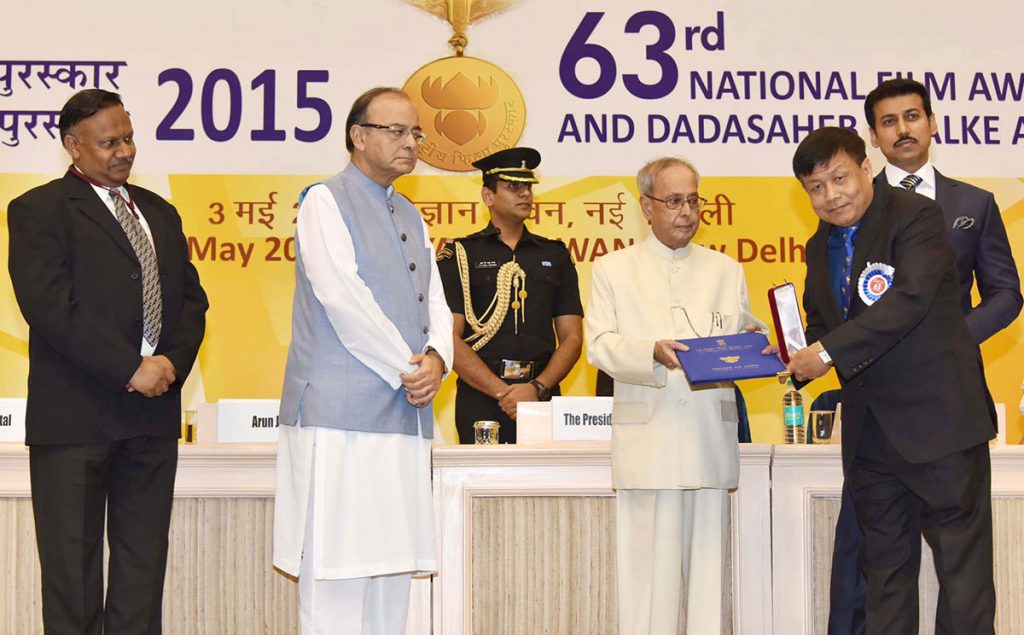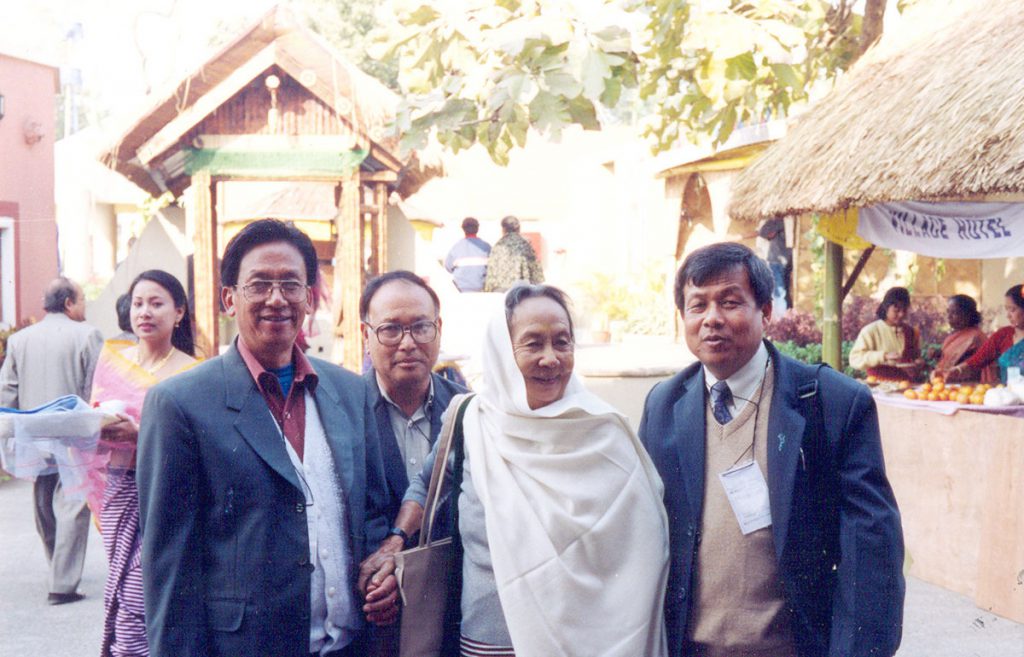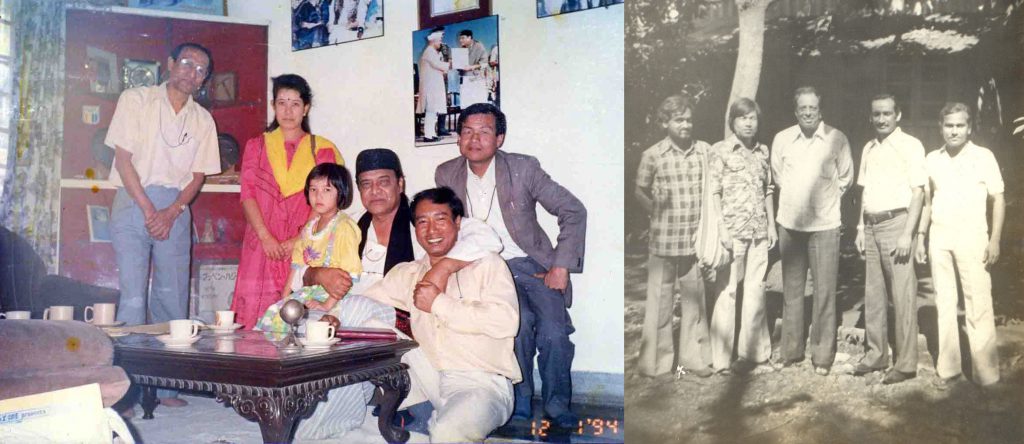
Meghachandra Kongbam’s eyes sparkle when he describes his first visit to a local movie theatre. He was ten years old and his father and aunt wanted to reward him for sitting the Grade 5 Board examination. He remembers walking with them in eager anticipation through Imphal’s Paona market to watch the Sunil Dutt-Nutan starrer Milan at Pratap Talkies, and when they couldn’t get tickets, on to Friends Talkies close by to watch Dil Ne Phir Yaad Kiya, starring Dharmendra and Nutan. In the 1960s, if your elders wanted to reward you, they took you to the movies and these were usually Hindi films whose songs were already popular on the radio. At 63, Meghachandra still remembers that day and all the songs from Milan and Dil Ne, because it was that walk through Paona market that stirred his passion for films and led him to study Journalism and to go on and win the Best Film Critic Award at the 63rd National Film Awards 2015.
But there is another aspect to Meghachandra, and that is his encyclopaedic knowledge of Manipur’s own 48-year-old film industry. When he was 14, Meghachandra had the rare opportunity to closely witness the making of what might have been the state’s first full length movie - S.N. Chand’s Brojendragi Luhongba. It was the summer of 1971 and the film crew turned up in his neighbourhood to shoot three sequences of the movie. Meghachandra remembers that day so vividly that he can describe in minute detail not only all the sequences that were shot but also the chatter of the town’s people who had gathered in large numbers to watch what seemed like the making of history. Brojendragi Luhongba ultimately ran out of funds and lost the race to Debkumar Bose's Matamgi which in 1972 became the first full length Manipuri feature film. But for Meghachandra, this was the start of a lifelong passion for Manipuri cinema – a passion not just for watching and reviewing movies for his readers, but also to raise awareness about the state’s film industry in the rest of the country. That’s why he calls himself a film activist and his admirers call him a ‘film whisperer’.
Besides being a regular film columnist for the leading Manipuri newspaper, Poknapham Daily, Meghachandra is also a founder member of Cine Artistes and Technicians Association, Manipur – an apex body of film scholars, critics, film makers, artistes and technicians, which was established in 1998. He is the President of Manipur Film Society, one of the oldest film societies in North East India and an advisor to the Manipur Film Journalists and Critics Association.
Meghachandra has even acted in plays directed by Ratan Thiyam of Chorus Repertory Theatre, was an approved artiste with All India Radio in Imphal and is currently the Chairman of the Banian Repertory Theatre. He retired in 2018 as Director in the Department of Information and Public Relations, Government of Manipur, after more than 36 years of service.
But it is cinema, and that too cinema of the Northeast, that animates Meghachandra. In this interview with the NEStories, he rejoices in the strides that the film industries of Assam, Meghalaya and Arunachal Pradesh are making, but bemoans the proliferation of a video film culture in Manipur and the lack of good quality equipment in the state’s movie halls. Most importantly, he believes the Information and Broadcasting Ministry must show a keener interest in the region. The opportunities, he believes are endless. The Northeast has more than 220 ethnic communities with their own beautiful dialects and distinctive ways of life. There are so many unexplored stories in the region just waiting to be made into movies, he says.

You received the ‘Best Film Critic’ at the 63rd National Film Awards in 2016? What was your reaction? Why do you think you are selected for the award?
I was overjoyed when I was unexpectedly informed by the legendary film maker Aribam Syam Sharma over phone that I had won the title. I assume it is an honour for Manipuri cinema as well. It encouraged me to keep writing on cinema. The selection was made by a three-member jury- one from literature, one from film reviews and one from filmmaking. The jury team, when I met them ataward’s dinner told me that they had unanimously picked me up for the award.
Do you write/critique Manipuri films as well? How do you select films to review?
I write on subjects that I feel are relevant to both Manipuri and regional cinema in the hope that it will bring about change. I also write articles on regional cinema for my international readers. If a film, Indian or international has some uniqueness to it, I will write about it. But as a film activist I write a lot about the problems of the Manipuri film industry. I have been writing seriouslyon cinema since 1985.
Do you see similarities in Manipuri films and Bollywood? Any difference?
Like Bollywood, Manipuri cinema had a lot of dance and songs. The audience in Manipur has grown up on Hindi cinema.Touring cinema arrived here in the 1920s.There has always been an appetite for movies in Manipur. Bollywood films have always run to full houses. Apart from ten cinema halls in Imphal, there were around sixty cinema halls scattered in other major towns of the state with a regular feature of three shows daily and four shows on Sundays.
Manipur got it first taste of regional cinema with song and dance with Debkumar Bose’s Matamgi Manipur, which simultaneously released at Usha Cinema, Friends Talkies in Imphal and at Azad Talkies in Kakching on April 9, 1972. Like in mainstream Hindi cinema, where the producers had a hero, a heroine and a villain in almost all their stories, Manipuri films also followed the same structure. The only difference was that Bollywood films target a national audience, Manipuri films a regional audience. Bollywood films emphasize the entertainment element to attract a diverse audience, including an international audience; Manipuri films reflect the culture and identity of its people and attempt to deliver a true account of the contemporary issues of the region.

What is unique about Manipuri films?
Manipuri films reflect its rich culture with its different forms of unique elegant dances, enchanting songs and colourful performing arts; Manipuri cinema has emerged with its own identity. Our costumes are different and being of the Mongoloid race, our gestures are also different from the Aryans and Dravidians. The Manipuri language belongs to Tibeto-Burman family with its own script.
Do you think Manipur produces art films?
Realistic films are generally known as art films. Commercial films are those films which are made for entertaining a large audience to collect huge revenue. Few film directors like Aribam Syam Sharma, M.A. Singh, K. Ibohal Sharma, Oken Amakcham, Makhonmani Mongsaba, Maipaksana Haorongbam, and Haobam Paban Kumar have made so-called art films.
Most films in Manipur are melodramatic. Do you think there are fewer story writers or film makers that are not bold enough to make film that reflect realities?
Film makers assume that the Bollywood style of melodramatic stories can attract a bigger audience. As for story writers, there are a lot of reputed writers in the field of Manipuri literature. It appears that those writers are closely associated with Manipuri theatre rather thanfilms. Many film makers in Manipur are not trained in film institutes. Haobam Paban Kumar is the only living filmmaker in Manipur having trained in Satyajit Ray Film and Television Institute, Kolkata.
Can you recollect some of the early years of film making in Manipur?
In the summer of 1971, I had an opportunity to watch the shooting of S.N. Chand’s Brojendragi Luhongba at my locality. S.N. Chand along with his crew members took shots for three important sequences of his film at the historic Ningthem Pukhri, the big royal pond dug out during the reign of King Pamheiba (1709-1748). People from near and far thronged the place to watch the outdoor shooting of the Manipuri film. I was also in the audience. I remember people in the crowd talking about this being the first Manipuri feature film and that the hero had had plastic surgery done to his nose! The film couldn't be completed on time due to financial problems and Debkumar Bose’s Matamgi Manipur got the credit of being the first Manipuri film which was released on April 9, 1972.
Cinema halls in Manipur meant a great deal then – take us through the journey.
Growing up, there were only five cinema halls - Victory Cinema, Friends Talkies, Imphal Talkies, Pratap Talkies and Usha Cinema in the heart of Imphal city. Except Imphal talkies which stood at Bir Tikendrajit Road, others stood along Paona Road. Paona Road was always busy because the cinema halls ran their show at 11 am, 2pm and 5pm daily. On Sundays, there was a morning show at 8 am. Later on, there were twin theatres - Asha Cinema and Jina Cinema at North AOC, Shankar Talkies and Mini Shankar at Lamphelpat and Mini Friends at Governor's Road. Cinema halls were meeting place for lovebirds and were an important part of one's life. In Manipur, there were about 60 cinema halls. Due to the wrong policy of the State Government that allowed the screening of Manipuri video films in the cinema halls in 2002, Manipuri cinema has been facing a dark period. As a result, there is no cinema hall with a digital projector in Manipur except that of Manipur State Film Development Society auditorium.
How has big screencinema evolved in Manipur?
Manipuri cinema fails to match the ongoing evolution of digital cinema around the world. Unfortunately, the Art and Culture Department has been the nodal department for films since 1980 in Manipur. The link between the Ministry of Information and Broadcasting in the centre and the Art and Culture Department has been cut off in Manipur as far as the development of the film medium is concerned. The Art and Culture Department has been promoting Manipuri video films in place of Manipuri celluloid/digital films. It might have done without knowing the difference between films and video films as defined by the Ministry of Information and Broadcasting. In North-East India, the film industries of Assam, Meghalaya and Arunachal Pradesh are moving ahead of the Manipuri film industry.
Can we say Film production in Manipur is an industry?
No. The entertainment industry in Manipur is the video film industry, not a film industry. When there is not even a single cinema hall equipped with a digital projector, and there is no production of Manipuri films in Manipur, how can we see a film industry? And as far as the market goes, it would be better to ask the Central Board of Film Certification if somebody wants to know the number of Manipuri films produced in a year. When there are no Manipuri films certified by the Board, where is the market?

What are you think is the most challenging for a film maker or a producer in Manipur?
There is no professional film maker or producer in Manipur.They need to acquire sufficient knowledge on the marketing of films. They must always respect the film medium.
Despite difficulties or challenges there are a good number of films being produce in Manipur. Some films, actors get awards. What could be the motivation etc?
Yes. With their individual efforts, some have achieved national or international recognition. They brought laurels to the state. They must be encouraged with incentives so that they can continue their efforts to achieve more.
Cinema from Manipur and NE at large are being noticed now. Where do you see the film making and film production in the next five to 10 years?
With the announcement of a good Assam Film Policy in 2019, I believe the future of Assamese cinema is certainly bright. In Meghalaya, the state has already announced film as industry and some renowned film makers like Pradip Kurbah, Dominic Sangma, Nicholas Kharkonger have emerged to uplift their cinema for a global art house audience. Manipur’s new film policy was announced in 2020, but it is not a realistic structured policy. There is no financial incentive for growth of either film production or the film market.
We have seen the potential of cinema in Northeast India and each state has produced its own outstanding films. Hence, there is need for strong support from the Government to provide basic services for the film industry. There are so many unexplored stories in the region which can inspire some unique films for both domestic and global market. It is time now to pressure the Information and Broadcasting Ministry to conducta biennial conference so that a programme for the growth of quality regional cinema is put in place.

Story Partner: Media9

